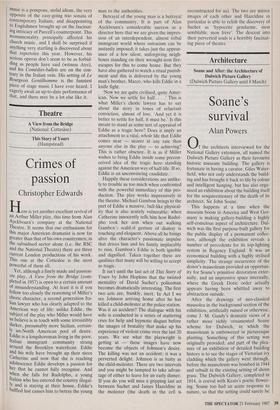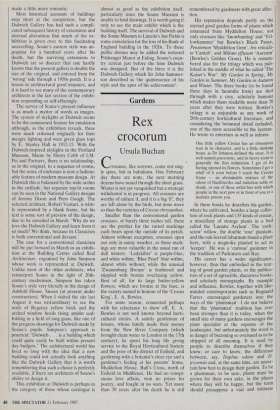Architecture
Soane and After: the Architecture of Dulwich Picture Gallery (Dulwich Picture Gallery until 8 March)
Soane's survival
Alan Powers
Of the architects interviewed for the National Gallery extension, all named the Dulwich Picture Gallery as their favourite historic museum building. The gallery is fortunate in having a curator, Giles Water- field, who not only understands the build- ing and has brought it back to life by colour and intelligent hanging, but has also orga- nised an exhibition about the building itself for the sesquicentenary of the death of its architect, Sir John Soane.
This happens at a time when the museum boom in America and West Ger- many is making gallery-building a highly self-conscious aspect of architecture. Dul- wich was the first purpose-built gallery for the public display of a permanent collec- tion, although the exhibition reveals a number of precedents for its top-lighting system in Regency England. It was an economical building with a highly stylised simplicity. The strange occurrence of the donor's mausoleum provided an opportun- ity for Soane's primitive decoration exter- nally, and an impressive space internally, where the Greek Doric order actually appears having been whittled away to abstraction outside.
After the drawings of neo-classical mausolea in the background section of the exhibition, artificially ruined or otherwise, come J. M. Gandy's dramatic views of a rather more richly ornamented Soane scheme for Dulwich, in which the mausoleum is embowered in picturesque planting. Something of this setting was originally provided, and part of the plea- sure of an exhibition of detailed building history is to see the stages of Victorian ivy cladding which the gallery went through, before the mausoleum was bombed in 1944 and rebuilt in the existing setting of shorn grass. The Dulwich Gallery, completed in 1814, is coeval with Keats's poetic flower- ing. Soane too had an acute response to nature, so that the setting could surely be made a little more romantic.
Most historical accounts of buildings stop short at the completion, but the Dulwich Gallery has had such a compli- cated subsequent history of extensions and internal alterations that much of the ex- hibition is given over to this fascinating unravelling. Soane's austere style was un- popular for a hundred years after his death, but the surviving extensions to Dulwich are so discreet that one hardly knows that the present gallery is double the size of the original, and entered from the `wrong' side through a 1950s porch. It is a lesson in architectural good manners, and it is hard to see many of the contemporary architects in the last section of the exhibi- tion responding so self-effacingly.
The survey of Soane's present influence is as much a matter of words as images. The system of skylights at Dulwich seems to be the commonest feature for emulation although, as the exhibition reveals, these were much criticised originally for their meagre lighting and were given glass tops by E. Stanley Hall in 1912-15. With the Dulwich-inspired skylights in the Portland Museum, Maine by Henry Cobb of I.M. Pei and Partners, there is no relationship, as in the original, to a sequence of rooms, but the sense of enclosure is now a fashion- able feature of modern museum design. At Dulwich this is balanced by the wide arches in the enfilade, but separate top-lit rooms can be seen in the National Gallery designs of Jeremy Dixon and Piers Gough. The selected architect, Robert Venturi, is witti- ly represented by a blank frame, but his text is some sort of preview of the design, due to be unveiled in March: 'Why do we love the Dulwich Gallery and learn from it so much? We think, because its Classicism is both conventional and deviant.'
The case for a conventional classicism will be put forward in March in an exhibi- tion at the Building Centre called Real Architecture, organised by John Simpson whose work is represented at Dulwich. Unlike most of the other architects, who reinterpret Soane in the light of 20th- century modernism, Simpson has taken Soane's style very literally in the design of Ashfold House, Sussex (at present under construction). When I visited the site last August it was extraordinary to see the walls of Regency yellow brick and the arched window heads rising amidst scaf- folding in a field of long grass, like one of the progress drawings for Dulwich made by Soane's pupils. Simpson's approach is practical: 'Dulwich . . . is a building which could quite easily be built within present day budgets.' The architectural world has lived so long with the idea that a new building could not actually look anything like the Dulwich Gallery that it is worth remembering that such a choice is perfectly available, if there are architects of Soane's ability to design it.
This exhibition at Dulwich is perhaps in the category of those whose catalogue is almost as good as the exhibition itself, particularly since the Soane Museum is unable to lend drawings. It is worth going if only to see the main exhibit which is the building itself. The survival of Dulwich and the Soane Museum in Lincoln's Inn Fields is some consolation for the loss of his Bank of England building in the 1920s. To these public shrines may be added the restored Pitshanger Manor at Ealing, Soane's coun- try retreat just before the time Dulwich was designed. But of the three it is the Dulwich Gallery which Sir John Summer- son described as 'the quintessence of his style and the apex of his achievement'.



















































 Previous page
Previous page